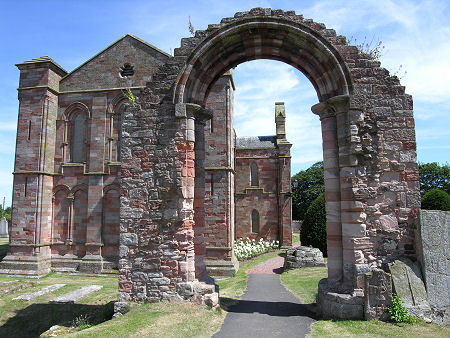 Coldingham Priory |
Saint Aebbe, Abb or Ebba is sometimes known as Aebbe the Elder to avoid confusion with a later Saint Aebbe who may have been associated with the monastery here in the 800s. She lived from 615 to 25 August 683. The wider picture in Scotland at the time is set out in our Historical Timeline.
Aebbe was born a princess, the daughter of King Aethelfrith of Bernicia and his wife Acha of Deira. Aethelfrith had married Acha in 604 after invading Deira, and becoming the first King of a unified Northumbria. In 616 the deposed King Edwin of Deira returned from exile and defeated Aethelfrith to become the second King of Northumbria. Aethelfrith's children, including Aebbe, were sent to safety in the court of King Domnall Brecc of Dalriada. While in exile they were converted to Christianity by the followers of Saint Columba.
Aebbe's brother Oswald, later to become St Oswald, reclaimed the throne of Northumbria. Aebbe also returned to the land of her birth, where under the guidance of Finan, Bishop of Lindisfarne, she became a nun in the 630s: by some accounts to avoid the attentions of a Prince Aidan. With her brothers' support, Aebbe established a monastery on the site of an old Roman fort at Ebchester. In about 635 she established a much better known religious house, probably on a rocky headland known as Kirk Hill. This lies immediately south of St Abbs Head, later named after Aebbe. The foundation she established was a "double separate monastery" which provided for separate communities of monks and nuns governed by an abbess: in this case Aebbe. One visitor to Aebbe's monastery was St Cuthbert of Lindisfarne, who early each morning bathed in the sea in Horsecastle Bay, beneath the cliffs on which the monastery stood. One morning a monk said he saw two otters miraculously swim out to join Cuthbert.
Rightly or wrongly, double separate monasteries, often occupied by the younger children of the aristocracy, tended to gain a reputation for misconduct incompatible with any of their vows, including that of chastity. Aebbe herself has a reputation for piety, but it seems that she was not always in complete control of the those in her charge. One night one of the monks, Adomnan, had a dream that the monastery would be burned down as God's punishment, though not during Aebbe's lifetime. The dream had the effect of bringing the monks and nuns into line for a while. However, when Aebbe died at the monastery on 25 August 683, the revelry that followed caused a fire that did indeed burn it to the ground.
Aebbe was later made a Saint, with a feast day on 25 August. According to one account written by the English monk Matthew Paris in the 1300s, her monastery at St Abbs Head was later rebuilt, possibly only as a nunnery. It was then completely destroyed in a Viking attack in 870. The abbess at the time of the attack was also called Aebbe, usually referred to Aebbe the Younger to avoid confusion, and for her conduct during the Viking raid she also later achieved sainthood. This may simply be invention or misunderstanding on Paris's part, because others believe that after the fire in 683, the monastery was abandoned and largely forgotten except in the name of Kirk Hill, on which it had stood. When, in 1098, King Edgar asked the Benedictines at Durham to establish what became Coldingham Priory, the site chosen was nearly two miles to the south-west in what is now Coldingham.
